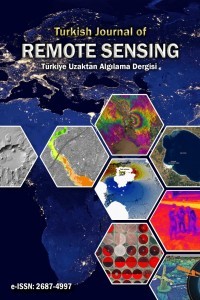Görüntü Eşleştirme Kaynaklı Nokta Bulutu Üzerinden Otomatik Bina Çıkarımı ve Düzgünleştirme
Fotogrametri, Nokta Bulutu, Bina Çıkarımı, I-Octree, Sayısallaştırma
Automatic Building Extraction and Regularization from Image Matching Based Point Cloud
Photogrammetry, point cloud, building extraction, I-Octree, digitalization,
___
- Alidoost, F., Arefi, H. (2015). An image-based technique for 3d building reconstruction using multi-view UAV images. International Archives of the Photogrammetry, Remote Sensing and Spatial Information Sciences - ISPRS Archives (C. 40).
- Alidoost, Fatemeh, Arefi, H., Tombari, F. (2019). 2D image-to-3D model: Knowledge-based 3D building reconstruction (3DBR) using single aerial images and convolutional neural networks (CNNs). Remote Sensing, 11(19).
- Bulatov, D., Häufel, G., Meidow, J., Pohl, M., Solbrig, P., Wernerus, P. (2014). Context-based automatic reconstruction and texturing of 3D urban terrain for quick-response tasks. ISPRS Journal of Photogrammetry and Remote Sensing, 93.
- Cao, Z., Fu, K., Lu, X., Diao, W., Sun, H., Yan, M., Yu, H., Sun, X. (2019). End-to-End DSM Fusion Networks for Semantic Segmentation in High-Resolution Aerial Images. IEEE Geoscience and Remote Sensing Letters, 16(11).
- Christian Rose, J., Paulus, S., Kuhlmann, H. (2015). Accuracy analysis of a multi-view stereo approach for phenotyping of tomato plants at the organ level. Sensors (Switzerland), 15(5).
- Dal Poz, A. P., Yano Ywata, M. S. (2020). Adaptive random sample consensus approach for segmentation of building roof in airborne laser scanning point cloud. International Journal of Remote Sensing, 41(6). Ester, M., Kriegel, H.-P., Sander, J., Xu, X. (1996). A Density-Based Algorithm for Discovering Clusters in Large Spatial Databases with Noise. 2nd International Conference on Knowledge Discovery and Data Mining, 96(34).
- Gilani, S. A. N., Awrangjeb, M., Lu, G. (2016). An automatic building extraction and regularisation technique using LiDAR point cloud data and orthoimage. Remote Sensing, 8(3).
- Hermosilla, T., Ruiz, L. A., Recio, J. A., Estornell, J. (2011). Evaluation of automatic building detection approaches combining high resolution images and LiDAR data. Remote Sensing, 3(6).
- Jayaraj, P., Ramiya, A. M. (2018). 3D CityGML building modelling from lidar point cloud data. International Archives of the Photogrammetry, Remote Sensing and Spatial Information Sciences - ISPRS Archives (C. 42).
- Ji, S., Wei, S., Lu, M. (2019). A scale robust convolutional neural network for automatic building extraction from aerial and satellite imagery. International Journal of Remote Sensing, 40(9).
- Karsli, F., Dihkan, M., Acar, H., Ozturk, A. (2016). Automatic building extraction from very high-resolution image and LiDAR data with SVM algorithm. Arabian Journal of Geosciences, 9(14).
- Kendall, A., Martirosyan, H., Dasgupta, S., Henry, P., Kennedy, R., Bachrach, A., Bry, A. (2017). End-to-End Learning of Geometry and Context for Deep Stereo Regression. Proceedings of the IEEE International Conference on Computer Vision (C. 2017-October).
- Lai, X., Yang, J., Li, Y., Wang, M. (2019). A building extraction approach based on the fusion of LiDAR point cloud and elevation map texture features. Remote Sensing, 11(14).
- Li, X., Ling, F., Foody, G. M., Du, Y. (2016). A superresolution land-cover change detection method using remotely sensed images with different spatial resolutions. IEEE Transactions on Geoscience and Remote Sensing, 54(7).
- Liu, J., Ji, S. (2020). A novel recurrent encoder-decoder structure for large-scale multi-view stereo reconstruction from an open aerial dataset. Proceedings of the IEEE Computer Society Conference on Computer Vision and Pattern Recognition.
- Malihi, S., Valadan Zoej, M. J., Hahn, M., Mokhtarzade, M., Arefi, H. (2016). 3D Building Reconstruction Using Dense Photogrammetric Point Cloud. The International Archives of the Photogrammetry, Remote Sensing and Spatial Information Sciences, XLI-B3.
- Marullo, S., Patsaeva, S., Fiorani, L. (2018). Remote sensing of the coastal zone of the European seas. International Journal of Remote Sensing, 39(24).
- Nan, L., Wonka, P. (2017). PolyFit: Polygonal Surface Reconstruction from Point Clouds. Proceedings of the IEEE International Conference on Computer Vision (C. 2017-October).
- Ozdemir, E., Karsli, F., Kavzoglu, T., Bahadir, M., Yagmahan, A. (2021). A novel algorithm for regularization of building footprints using raw LiDAR point clouds. Geocarto International, 1-23.
- Rau, J. Y., Jhan, J. P., Hsu, Y. C. (2015). Analysis of oblique aerial images for land cover and point cloud classification in an Urban environment. IEEE Transactions on Geoscience and Remote Sensing, 53(3).
- Rutzinger, M., Rottensteiner, F., Pfeifer, N. (2009). A Comparison of Evaluation Techniques for Building Extraction from Airborne Laser Scanning. IEEE Journal of Selected Topics in Applied Earth Observations and Remote Sensing, 2(1).
- Shao, Z., Yang, N., Xiao, X., Zhang, L., Peng, Z. (2016). A multi-view dense point cloud generation algorithm based on low-altitude remote sensing images. Remote Sensing, 8(5).
- Siddiqui, F. U., Teng, S. W., Awrangjeb, M., Lu, G. 2016. A robust gradient based method for building extraction from LiDAR and photogrammetric imagery. Sensors, 16(7).
- Sun, W., Wang, R. (2018). Fully Convolutional Networks for Semantic Segmentation of Very High Resolution Remotely Sensed Images Combined with DSM. IEEE Geoscience and Remote Sensing Letters, 15(3).
- Tran, T. N., Drab, K., Daszykowski, M. (2013). Revised DBSCAN algorithm to cluster data with dense adjacent clusters. Chemometrics and Intelligent Laboratory Systems, 120.
- Wu, Z., Wu, X., Zhang, X., Wang, S., Ju, L. (2019). Semantic stereo matching with pyramid cost volumes. Proceedings of the IEEE International Conference on Computer Vision (C. 2019-October).
- Yan, Y., Gao, F., Deng, S., Su, N. (2017). A hierarchical building segmentation in digital surface models for 3D reconstruction. Sensors, 17(2).
- Zhang, F., Prisacariu, V., Yang, R., Torr, P. H. S. (2019). GA-net: Guided aggregation net for end-to-end stereo matching. Proceedings of the IEEE Computer Society Conference on Computer Vision and Pattern Recognition (C. 2019-June).
- Başlangıç: 2019
- Yayıncı: Osman ORHAN
Sedimanter Uranyum Yataklarının Uzaktan Algılama Destekli Aranmasına Yönelik Metot Önerisi
Emirhan ÖZDEMİR, Kasım ERDAL, Fehmi VEZİROĞLU, Seyfullah Sinan ATEŞ
Sentinel-5p Uydu Görüntüleri İle Azot Dioksit (NO2) Kirliliğinin İzlenmesi
Görüntü Eşleştirme Kaynaklı Nokta Bulutu Üzerinden Otomatik Bina Çıkarımı ve Düzgünleştirme
Buray KARSLI, Ferruh YILMAZTÜRK
Rouhollah JAFARI-SIRIZI, Amir OSHNOOEI-NOOSHABADI, Zeinab KHABBAZI-KENARI, Alireza SADEGHI
